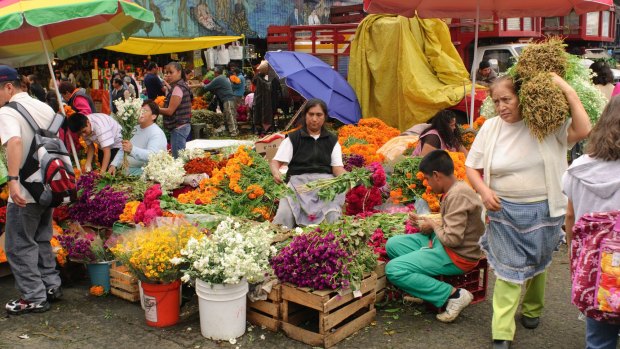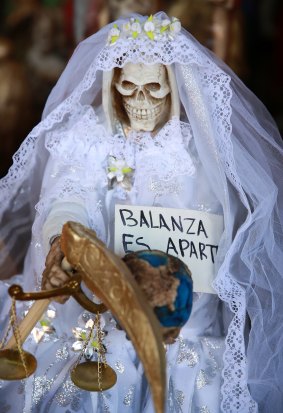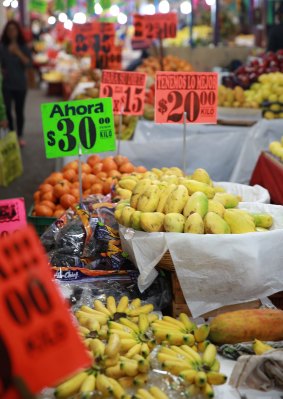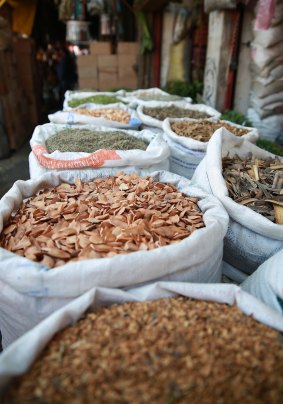This was published 8 years ago
Mercado Jamaica, Mexico City: The market with the secret ingredient to every lip-smacking Mexican dish
By Catherine Marshall

Colourful assortment: Mercado Jamaica.Credit: Alamy Stock
There's a secret ingredient that's added to every lip-smacking Mexican dish: politics. It flavours the tamales made from corn down at Mercado Abelardo L. Rodriguez. It laces the huaraches filled with smashed beans and nopal at Mercado Jamaica on the other side of town. It tempers the mezcal and pulque and tequila made from agave near the Teotihuacan pyramids on the city's north-eastern fringe.
This entanglement of food and politics comes to life in the vestibules and porticos of Mercado Abelardo L. Rodriguez, a market built in 1934 and named for the president who ordered its construction. Here, Mexico's most prominent male artist, Diego Rivera, supervised his students in the application of murals that stretch all the way up the buildings' walls and meet midpoint on its ceilings.
The murals are faded and peeling now – a restoration project is underway – but they were an important tool in 1930s Mexico, schooling illiterate people in the importance of corn and agave in their own agrarian economies.

Figurines at Mercardo Sonora.Credit: Catherine Marshall
"Rivera said, 'If Mexicans don't have corn, they don't have anything'," Urban Adventures guide Pilar Carrasco says. "Corn is our gold."
But they also tell the story of the theft of the peasants' livelihood: here are the striking farmworkers, banners held aloft, fists raised in defiance; there are the policemen, quashing the insurrection, the fat businessmen counting their money, the emaciated man dying on the street. And all over these walls are the women, carrying so much of the load, as always.
"I see all the problems here still in Mexico," Carrasco says. "I see the men getting drunk and the women doing all the work. It's a power fight we still have today."

Produce at Mercardo Jamaica.Credit: Catherine Marshall
At a kiosk inside the market, those golden kernels of corn which Rivera spoke of have been milled into flour and transformed into that Mexican staple, tamales. They're stuffed with chilli, wrapped in corn husks and steamed inside a big pot. The resulting dish is bland by appearance, flavoursome by taste. I wash mine down with coffee sweetened with piloncillo.
Rivera's socialist murals have alerted me not only to issues of land restitution and food production, but to another entrenched element of Mexican society: religion. An avowed atheist, Rivera refused to remove from one of his murals an inscription that read "God does not exist".
But at Mercado de Sonora – a short journey from here on the subway – the great artist's countrymen beg to differ. It's an eccentric little market blending an assortment of produce – sacks filled with dried herbs, mushrooms and coconut husks; bleating, day-old lambs – with the country's paganised version of Catholicism.

Produce at Mercado de Sonora.Credit: Catherine Marshall
It's a pastiche of Spanish colonialism, African slavery and Mayan and Aztec ancestry. There are stalls selling bottled snakes and frogs and orisha beads brought to Latin America by West African slaves. There are voodoo dolls and voodoo kits packaged in envelopes for easy selection: you can choose a potion that will rid you of enemies, help you find love, repel other voodoo spells – or transform you into a better Catholic.
There are candles carved in the likeness of Jesus Malverde – a Robin Hood-like bandit sainted by the Mexican people – and sculptures of saintly skeletons dressed in wedding attire. Noticing my curiosity, a stallholder hands me a tiny figurine, a skeleton that's draped in a flowing gold cape and carries a scythe. She looks like the grim reaper, but will bring me great luck, he says.
I carry the figurine with me on the subway to Mercado Jamaica. Among the acres and acres of fresh flowers sold here – you'll find a bloom to match the precise colour of your eyes! – I find Rivera's golden corn again, sizzling over red-hot coals, cooked into great big pots of gruel. Sitting beside this bounty are baskets overflowing with fried grasshoppers. Thinking of the starving peasants in Rivera's murals, I pop one into my mouth.
"It's better you eat them with tortilla and guacamole," Carrasco instructs.
We find a table at a canteen named for the food it sells: Huaraches Ramoncita. These tortillas are filled with whatever ingredients come to hand: chilli-flavoured grasshoppers, liver, sheep's stomach, cheese, eggs. I've had my fill of grasshoppers, so I choose as my filling a delicious salad made from the pads of the nopal cactus (prickly pear). It must surely be the most easy-to-come-by ingredient, flourishing as it does across the valleys and hills of Mexico. And so I detect in it a heavy seasoning of equality, too.
TRIP NOTES
MORE INFORMATION
GETTING THERE
Qantas flies to Mexico City from Sydney via Dallas/Fort Worth and from Melbourne via Los Angeles. Fares start at $1499 one way; see www.qantas.com.
TOURING THERE
Urban Adventures runs several day tours in Mexico City, ranging from five to 13 hours long. Prices start from $60; see www.urbanadventures.com.
Catherine Marshall travelled as a guest of Urban Adventures.
Sign up for the Traveller Deals newsletter
Get exclusive travel deals delivered straight to your inbox. Sign up now.